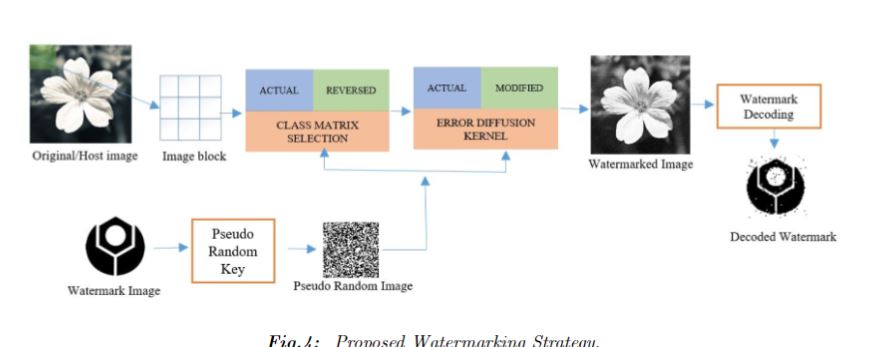Watermarking in dot-diffusion halftones using adaptive class-matrix and error diffusion
Main Article Content
Abstract
Digital halftoning deals with transforming a gray or color image into its binary version which is useful in printing applications. Dot diffusion is one of the prominent halftone methods which can yield superior image quality with parallel processing capabilities. In this paper, a rapid watermarking algorithm is proposed for dot-diffusion halftone images using adaptive class-matrix selection and modified error diffusion kernels. To process the image using an adaptive class matrix, the processing order of the class matrix is reversed and transposed, and for error diffusion the coefficients are replaced with different weights. For decoding, an effective strategy is proposed based on a correlation analysis and halftone statistics. The proposed strategy can successfully embed and decode the binary watermark from a single dot-diffused halftone image. From the experimental results, the proposed method is found to be effective in terms of good decoding accuracy, imperceptibility and robustness against various printed distortions.
Article Details
References
D. L. Lau, and G. R. Arce, Modern digital halftoning, CRC Press, 2008.
D. L. Lau, R. Ulichney, and G. R. Arce, “Blue and green noise halftoning models,” IEEE Signal Processing Magazine, vol. 20, no. 4, pp.28-38, Jul. 2003.
R. A. Ulichney, “Void-and-cluster method for dither array generation,” Human Vision, Visual Processing, and Digital Display IV, vol. 1913, pp. 332-344, Sep. 1993.
J. F. Jarvis, C. N. Judice, W. H. Ninke, "A survey of techniques for the display of continuous tone pictures on bi-level displays", Computer Graph. Image Process., vol. 5, no. 1, pp. 13-40, 1976.
D. E. Knuth, "Digital halftones by dot diffusion", ACM Trans. Graph., vol. 6, no. 4, pp. 245-273, Oct. 1987.
M. Mese, P. P. Vaidyanathan, "Optimized halftoning using dot diffusion and methods for inverse halftoning", IEEE Trans. Image Process., vol. 9, no. 4, pp. 691-709, Apr. 2000.
J. M. Guo and S. Sankarasrinivasan, “A Rapid Watermarking Strategy for Multi-Tone Images,” Asia-Pacific Signal and Information Processing Association Annual Summit and Conference (APSIPA ASC), pp. 1113-1117, Nov. 2018.
M. S. Fu, and O. C. Au, “Steganography in halftone images: conjugate error diffusion,” Signal Processing, vol. 83, no. 10, pp. 2171-2178, Oct. 2003.
D. Kacker, and J. P. Allebach, “Joint halftoning and watermarking,” IEEE Transactions on Signal Processing, vol. 51, no. 4, pp.1054-1068, Apr. 2003.
O. Taheri, A.M. Attar, S. Sadri, R.A. Fattahi, I. Hosseini, “Dot diffusion with nonlinear thresholding to hide data in halftoned images,” Information and Communication Technologies, vol. 1, pp. 1469-1473, 2006.
J.M. Guo, J.H. Huang, “Data hiding in halftone images with secret-shared dot diffusion,” Proceedings of the IEEE International Symposium on Circuits and Systems, pp. 1133-1136, 2010.
Y. Guo, et al. “Data hiding in dot diffused halftone images,” IEEE International Conference on Multimedia and Expo., pp. 1-6, Jul. 2011.
Goldschneider, J.R., Riskin, E.A. and Wong, P.W., “Embedded color error diffusion,” International Conference on Image Processing, vol. 1, pp. 565-568, Sep. 1996.
M. S. Fu, O. C. L. Au, “Hiding data in halftone image using modified data hiding error diffusion,” In Visual Communications and Image Processing International Society for Optics and Photonics, vol. 4067, pp. 1671-1681, May 2000.
J. Rosen, B. Javidi, “Hidden images in halftone pictures,” Applied Optics, vol. 40, no. 20, pp. 3346-3353, 2001.
Z. Baharav, D. Shaked, “Watermarking of dither halftoned images,” in Proc. Int. Conf. Security Watermark. Multimedia Content, pp. 307–316, May 1999.
J. M. Guo, S. C. Pei, and H. Lee, “Watermarking in halftone images with parity-matched error diffusion,” Signal Processing, vol. 91, no. 1, pp.126-135, Jan. 2011.
J. M. Guo, et. al “Digital Halftone Database (DHD): A Comprehensive Analysis on Halftone Types,” Asia-Pacific Signal and Information Processing Association Annual Summit and Conference (APSIPA ASC), pp. 1091-1099, Nov. 2018.


